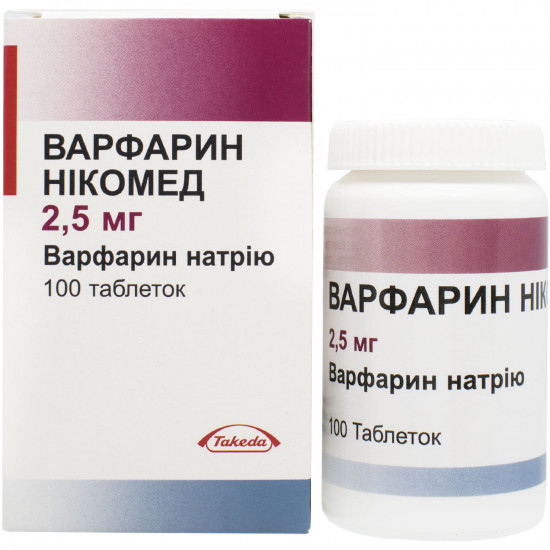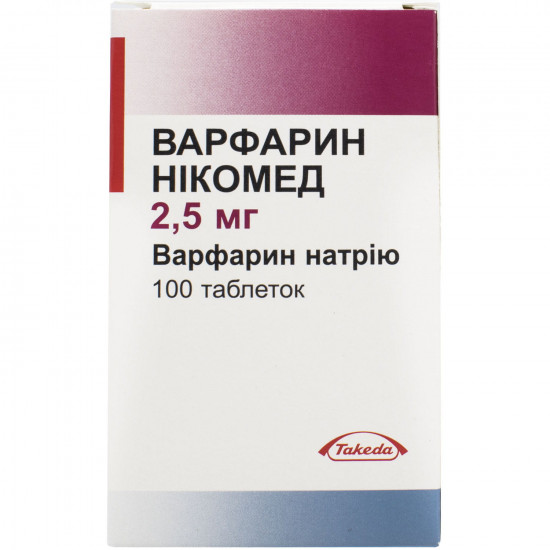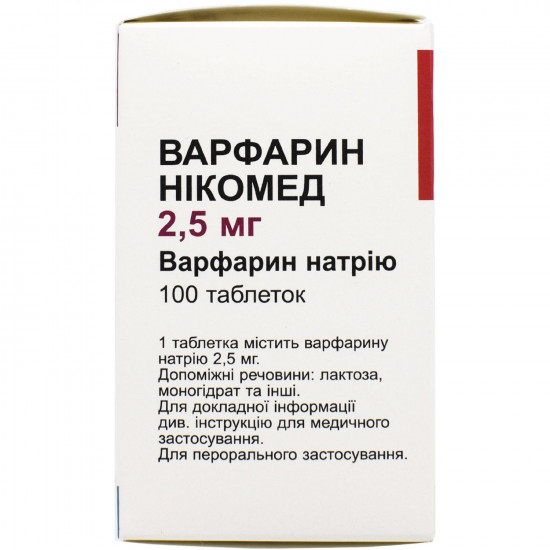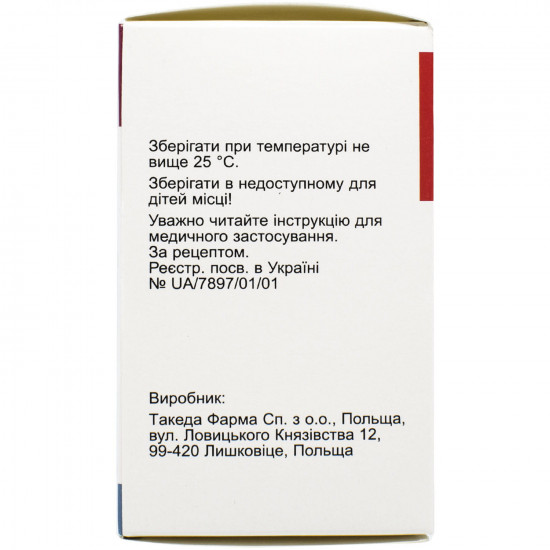







- Stock: In Stock
- Model: 184812
0% Customers recommend this product
-
5 Awesome0%
-
4 Great0%
-
3 Average0%
-
2 Bad0%
-
1 Poor0%
Reviews Over Nikomed warfarin of the tab. of 2.5 mg No. 100
- (0)
Total Reviews (0)
click here write review to add review for this product.
Report this review.
Description
tablets "Nikomed Warfarin" are applied at the following indications:
- prevention and treatment of a deep vein thrombosis and embolism of a pulmonary artery;
- secondary prevention of a myocardial infarction and prevention of tromboembolic episodes (stroke or a system embolism) after a myocardial infarction;
- prevention of tromboembolic episodes at patients with fibrillation of auricles, damages of heart valves or the fitted a prosthesis heart valves;
- prevention of the fast-taking place ischemic attacks and a stroke.
Structure
Active ingredient - sodium warfarin (one tablet contains warfarin of sodium 2.5 mg).
Excipients: dye indigotin (E 132); lactose, monohydrate; corn starch; povidone 30; calcium hydrophosphate; magnesium stearate.
Contraindication
- Hypersensitivity to medicament components; the bleeding which is clinically established ; in order to avoid risk of developing heavy bleedings within 72 hours after extensive surgeries, within 48 hours in a puerperal period, tendency to bleedings (hemophilia, Villibrand's disease; thrombocytopenia and dysfunction of thrombocytes); tendency to falling; heavy renal failure; heavy liver failure, cirrhosis; not treated or uncontrollable arterial hypertension; recent hemorrhagic stroke; the states causing intracraneal hemorrhage, for example, aneurysm of brain arteries, an aortic aneurysm; operations of the central nervous system or eye operations; gastrointestinal or renal bleedings and their complications, divertuculosis or malignant tumors; pericarditis (including exudative).
- State at which therapy cannot be carried out rather safely (for example psychoses, dementia, alcoholism). to
- medicament use Is contraindicated to women in the first trimester of pregnancy and within the last four weeks of pregnancy. to
- medicament use Is contraindicated to patients with the increased risk of developing bleeding (including to patients with hemorrhagic diathesis, a gullet varicosity, aneurysms of arteries, a lumbar puncture, stomach ulcer, heavy wounds (including operating rooms), cerebrovascular disorders with risk of a cerebral hemorrhage, a bacterial endocarditis and malignant arterial hypertension).
- Patients who receive treatment by warfarin should not use the drugs/medicaments of plant origin containing hypericum perforatum (a St. John's wort usual) as their combined use causes decrease in concentration of warfarin in blood plasma that leads to decrease in clinical effect in blood plasma.
Route of administration
Target INI (International Normalizing Index) level for oral anticoagulating therapy:
- prevention of tromboembolic episodes at patients with the fitted a prosthesis heart valves: RUMPLE 2.5-3.5.
- other indications: RUMPLE 2.0-3.0.
to Patients with normal body weight and spontaneous RUMPLE
lower than 1.2 to appoint 10 mg of warfarin within three next days. Then to calculate a dose according to data stated below according to measurements THINK for the fourth day.
At ambulatory patients and patients with hereditary insufficiency of a protein With or S recommended initial dose makes 5 mg of warfarin within three next days. Then to calculate a dose according to data stated below according to measurements THINK for the fourth day.
patients with hereditary insufficiency of an antitrombotichesky protein With at the beginning of therapy warfarin have a risk of developing necrosis of skin. At such patients the use of medicament needs to be begun without load dose of warfarin even if to the patient enter heparin.
in case of development of necrosis of skin should stop warfarin use.
For patients of advanced age, patients with small body weight, with spontaneous RUMPLE higher than 1.2 or those which have associated diseases or receive any medicines affecting efficiency of anticoagulating therapy, the recommended initial dose makes 5 mg of warfarin within two next days. Then the dose is calculated according to data stated below according to measurements THINK for the third day.
Recommended dosage of the medicament "Varfarin-FS":
- day of 1 - 10 (5.0) mg/days;
- day of 2 - 10 (5.0) mg/days;
- put 3:
- RUMPLE <2.0 - 10 (5.0) mg/days; RUMPLE
- from 2.0 to 2.4 - 5.0 mg/days; RUMPLE
- from 2.5 to 2.9 - 3.0 mg/days; RUMPLE
- from 3.0 to 3.4 - 2.5 mg/days; RUMPLE
- from 3.5 to 4.0 - 1.5 mg/days; RUMPLE
- > 4.0 - to miss one day of reception;
- put 4-6:
- RUMPLE <1.4 - 10.0 mg/days; RUMPLE
- from 1.4 to 1.9 - 7.5 mg/days; RUMPLE
- from 2.0 to 2.4 - 5.0 mg/days; RUMPLE
- from 2.5 to 2.9 - 4.5 mg/days; RUMPLE
- from 3.0 to 3.9 - 3.0 mg/days; RUMPLE
- from 4.0 to 4.5 - to miss one day of reception, then - 1.5 mg/days; RUMPLE
- > 4.5 - to miss two days of reception, then - 1.5 mg/days;
put - 7 (a week dose of the medicament "Varfarin-FS"): RUMPLE
- from 1.1 to 1.4 - increases by 20%; RUMPLE
- from 1.5 to 1.9 - increases by 10%; RUMPLE
- from 2.0 to 3.0 - the dose remains; RUMPLE
- from 3.1 to 4.5 - decreases by 10%; RUMPLE
- > 4.5 to miss reception while THINK will not become <4.5, then - to continue treatment by the dose reduced by 20%.
to carry out daily, it will not be reached yet the stable target level which usually is established for 5-6 day of treatment. Then RUMPLE measurements it is necessary to carry out weekly, reaching a 4 weeks interval. In case of big deviations in the THINK level or patients with diseases of a liver or with diseases which influence vitamin K absorption intervals of measurements can have less than 4 weeks. Prescribing of new medicines or cancellation of those which were accepted earlier demands carrying out additional measurements THINK. At long therapy the adjustment is carried out to a week dose of warfarin according to the data given above. If the dose demands correction, then RUMPLE the following measurement it is necessary to carry out in one or two weeks after correction. After this measurement proceed before achievement of 4 weeks intervals.
ChildrenTherapy by anticoagulants at children is carried out by
under observation of the pediatrician. Doses are selected according to the data given below.
Recommended dosage:
put- 1 - if if spontaneous THINK from 1.0 to 1.3, then the initial dose makes 0.2 mg/kg of body weight (0.1 mg/kg of body weight in an abnormal liver function);
- days from the 2nd for the 4th, if THINK value (maintenance dose):
- from 1.1 to 1.3 - to repeat an initial dose;
- from 1.4 to 1.9 - 50% of an initial dose;
- from 2.0 to 3.0 - 50% of an initial dose;
- from 3.1 to 3.5 - 25% of an initial dose;
- > 3.5 - to stop administration of medicament before achievement THINK <3.5, then - to resume treatment by the dose making 50% of the previous dose;
- maintenance therapy, if THINK value (week dose):
- from 1.1 to 1.4 - to increase a dose by 20%;
- from 1.5 to 1.9 - to increase a dose by 10%;
- from 2.0 to 3.0 - without changes;
- from 3.1 to 3.5 - to reduce a dose by 10%;
- > 3.5 - to stop administration of medicament before achievement THINK <3.5, then - to resume treatment by a dose 20% less previous.
Pre-, a feather - and postoperative anticoagulating therapy is carried out by
as it is provided below. to Define
THINK one week prior to the appointed operation.
to Stop intake of warfarin in 1-5 days prior to operation. In case of high risk of thrombosis the patient for prevention subcutaneously needs to enter low-molecular heparin. Pause duration in intake of warfarin depends from THINK. To stop intake of warfarin:
- in 5 days prior to operation if THINK> 4.0;
- in 3 days prior to operation if RUMPLE from 3.0 to 4.0;
- in 2 days prior to operation if RUMPLE from 2.0 to 3.0.
THINK in the evening before operation and to enter 0.5-1.0 mg of K1 vitamin inside or intravenously if THINK> 1.8.
to Take into account need of infusion of unfractionated heparin or preventive administration of low-molecular heparin in day of operation.
to Continue byhypodermic administration of low-molecular heparin within 5-7 days after operation with the accompanying restoration of intake of warfarin.
to Continue byintake of warfarin from a usual maintenance dose on the same day in the evening after small operations and in the afternoon when the patient begins to receive an enteroalimentation after large operations.
Pregnant
At use of medicament during pregnancy warfarin can result
Feature of use
in congenital defects and death of a fruit. Women of reproductive age have to apply effective methods of contraception during treatment. Warfarin quickly gets through a placenta. Antitrombotichesky therapy during pregnancy should be carried out individually under careful observation of the doctor.Warfarin can be applied during feeding by a breast. Warfarin is emitted in breast milk, but if the medicament is taken in therapeutic doses, then emergence of undesirable reactions in the newborn is not expected.
Drivers
Drug has no influence or has insignificant impact on ability to drive the car and other mechanisms.
Overdose
Increased THINK level is a key indicator of overdose of warfarin therefore the risk of developing of bleedings increases. Increase in the THINK level is correlated with a half-life period of blood-coagulation factors of VII. The increased THINK level is shown within 24 hours and reaches the maximum value within 36-72 hours after administration of drug.
Clinical manifestations occur in several days or weeks after administration of medicament and are characterized by nasal bleedings, bleeding of gums, pallor, hematomas around joints and buttocks, presence of blood in urine and Calais. Dorsodynias, bleeding of lips, bleeding of mucous membranes, an abdominal pain, vomiting and a petechia can be other symptoms. Further there can be the central paralysis owing to bleedings, plentiful bleedings and a lethal outcome.
Treatment. Symptomatic and maintenance therapy.
Side effects
Most frequent manifestations of side effect of warfarin are hemorrhages and bleedings which can arise from any body as desirable therapeutic effect is anticoagulating action (for example bleeding from a nose, a pneumorrhagia, a hamaturia, bleeding of gums, appearance of bruises, vaginal bleedings, hemorrhage in eye conjunctivas, rectal, gastrointestinal bleedings, intracerebral bleeding, long and plentiful bleedings after surgeries and after injuries). Bleedings can have serious character and lead to hospitalization, blood transfusion to patients who were on long anticoagulants treatment, and to a lethal outcome.
Storage conditionsto Store
at a temperature not above 25 °C, out of children's reach.
Expiration date - 5 years.
Specifications
| Characteristics | |
| Active ingredients | Warfarin |
| Amount of active ingredient | 2.5 mg |
| Applicant | Takeda |
| Code of automatic telephone exchange | B01AA03 Warfarin |
| Interaction with food | It doesn't matter |
| Light sensitivity | Not sensitive |
| Market status | Generic-generic |
| Origin | Vegetable |
| Prescription status | According to the prescription |
| Primary packing | bottle |
| Producer | TAKEDA OF THE JOINT VENTURE OF PHARM. |
| Quantity in packing | 100 tablets |
| Release form | tablets for internal use |
| Route of administration | Oral |
| Sign | Import |
| Storage temperature | from 5 °C to 25 °C |
| Trade name | Warfarin |
























































